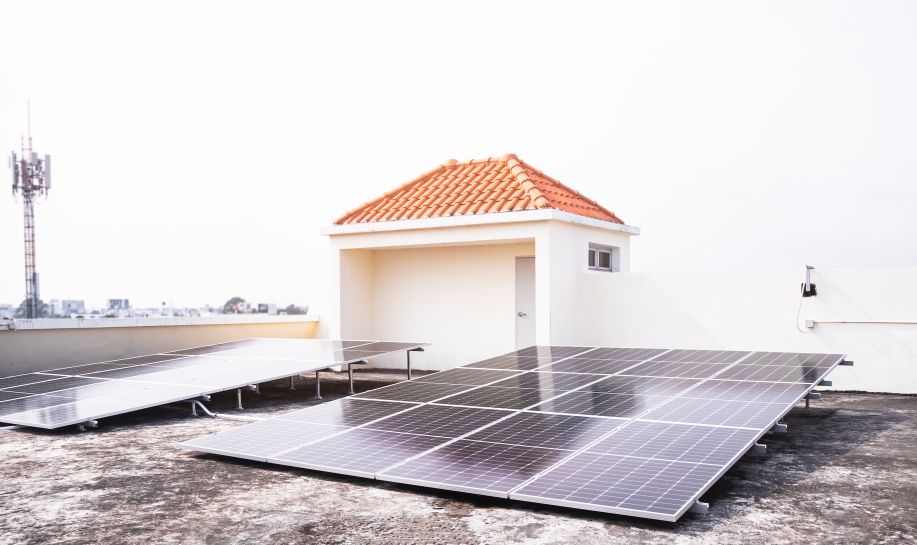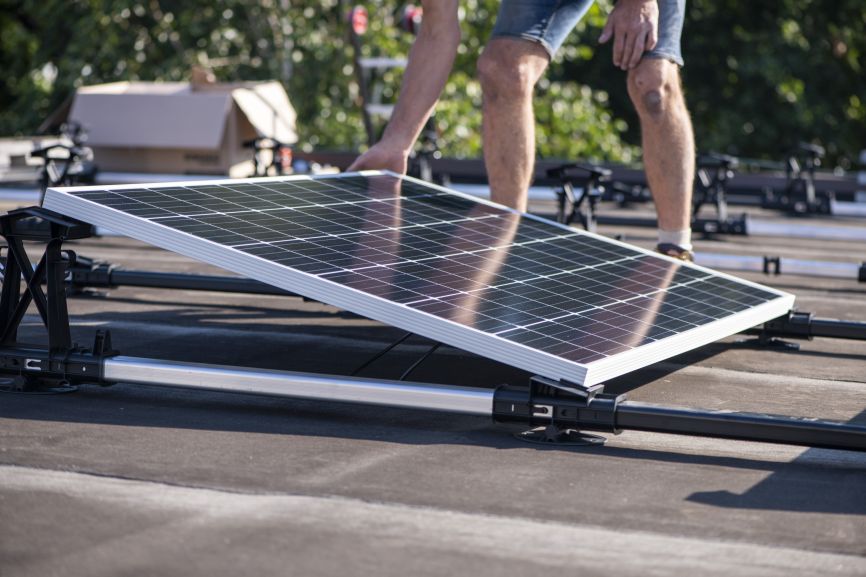Can You Put Solar Panels on a Flat Roof?
Yes, you can absolutely install solar panels on a flat roof. Instead of laying them flat, installers use special mounting systems that tilt the panels at the right angle to capture sunlight efficiently. This tilt also helps with rainwater drainage and reduces dirt buildup, making the system just as effective as panels on a sloped roof. Professional installers typically use tilt racks or ballasted mounts designed for your specific roof type, ensuring maximum energy output and long-term durability.

TL;DR – Are Solar Panels Suitable For A Flat Roof?
Yes, solar panels can be installed on a flat roof. Installers use tilt racks or ballasted mounts to angle panels correctly, improve sunlight capture, and allow rainwater to drain. With professional design, flat roof solar performs just as efficiently as on sloped roofs.
How Flat Roof Solar Panel Installations Work
Flat roof solar systems rely on specialized mounting solutions that give panels the tilt they need to perform efficiently. Most installations use tilt frames set at a 10–30° angle, which maximizes sun exposure and allows water and debris to slide off naturally. Installers typically choose between ballasted mounts, which are weighted down to avoid roof penetration, and anchored systems, which are secured directly into the structure. Both methods are designed to protect the roof membrane and ensure long-term stability. The best approach depends on your roof type – whether it’s EPDM rubber, TPO, or concrete – and your local weather conditions. By selecting the right mounting system, a flat roof can safely support a high-performing solar array without compromising the integrity of the building.
Benefits of Installing Solar Panels on a Flat Roof
Flat roofs come with several advantages for solar panel installations. Because panels can be oriented in any direction, installers can optimize the tilt and angle to capture maximum sunlight year-round. Installation is often simpler and safer compared to pitched roofs, since the surface is easier to access and work on. Flat roof systems also provide cleaner aesthetics, as panels are generally hidden from street view. In addition, the extra roof space allows for larger systems that generate more electricity, making it ideal for homes and commercial buildings with higher energy needs. Finally, flat roofs offer space to conceal inverters, batteries, or other equipment, keeping your system organized and your property looking uncluttered.
Challenges and Considerations
While flat roofs are excellent candidates for solar, there are some challenges to keep in mind. Ballasted systems add weight, so your roof must be able to handle the load safely. Proper waterproofing and drainage are critical – any pooling around mounts could damage the roof membrane. Panels also need to be set at the correct tilt to prevent dirt and dust from building up, which can lower efficiency. In some areas, local building codes and wind resistance requirements may limit how panels are mounted. Finally, the need for specialized mounting equipment can make flat roof installations slightly more expensive upfront than sloped systems, though the long-term savings usually outweigh the added cost.

Efficiency of Solar Panels on Flat Roofs
Solar panels on flat roofs can be just as efficient as those on sloped roofs when installed correctly. By using tilted mounting racks, panels can be angled toward the sun to maximize energy production. Some systems even feature adjustable racks, allowing seasonal tilt adjustments for peak efficiency throughout the year. If panels are left flat, there may be a minor efficiency loss due to reduced sun exposure and dirt buildup, but the system can still generate significant power. For example, a 5kW solar array on a flat roof with proper design and tilt can perform at nearly the same level as one on a pitched roof.
Cost of Flat Roof Solar Installations
Installing solar panels on a flat roof may come with slightly higher costs compared to a sloped roof, mainly due to the need for specialized mounting equipment. However, in some cases, ballasted systems can lower labor expenses since they don’t require extensive drilling or roof penetration. While the upfront price can be a bit higher, the long-term return on investment remains strong. Flat roof systems often last longer and are easier to maintain, helping homeowners save on both energy bills and future repair costs.
Professional Installation vs. DIY
Flat roof solar systems require expert engineering to handle factors like load capacity, tilt angle, and proper drainage. Attempting a DIY install can lead to costly mistakes such as roof leaks, poor panel orientation, or voided warranties. Professional installers not only design systems that maximize efficiency but also ensure compliance with local building codes and manufacturer guidelines. Choosing a certified installer gives you peace of mind that your investment is protected and built to last.
Is a Flat Roof Good for Solar?
Yes, a flat roof can be an excellent place for solar panels when installed with the right tilt or ballasted systems. The benefits – flexibility, efficiency, and extra roof space – far outweigh the challenges when the design is done properly. To maximize performance and protect your roof, it’s best to work with professional installers who can tailor the system to your home’s needs.
Ready to Install Solar on Your Flat Roof? Get a Free Quote
Thinking about making the most of your flat roof with solar? We connect you with certified local installers who design systems built for maximum efficiency and long-term reliability. Take advantage of rebates, tax incentives, and energy savings while gaining peace of mind with professional installation. Call today to get a free quote!
